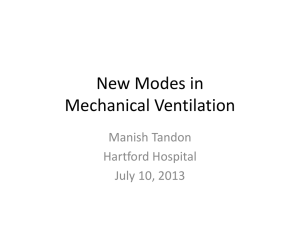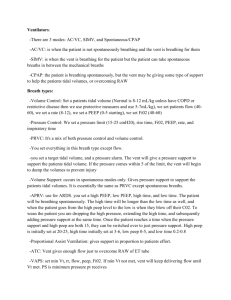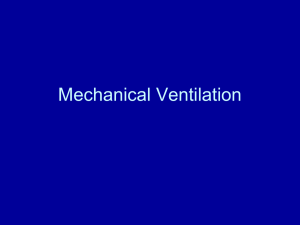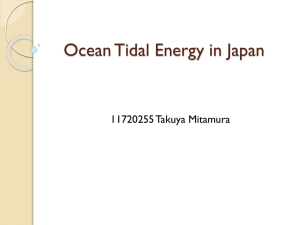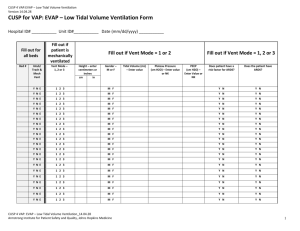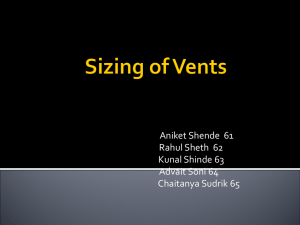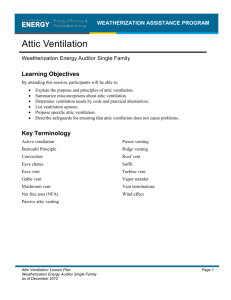Vents 101
advertisement
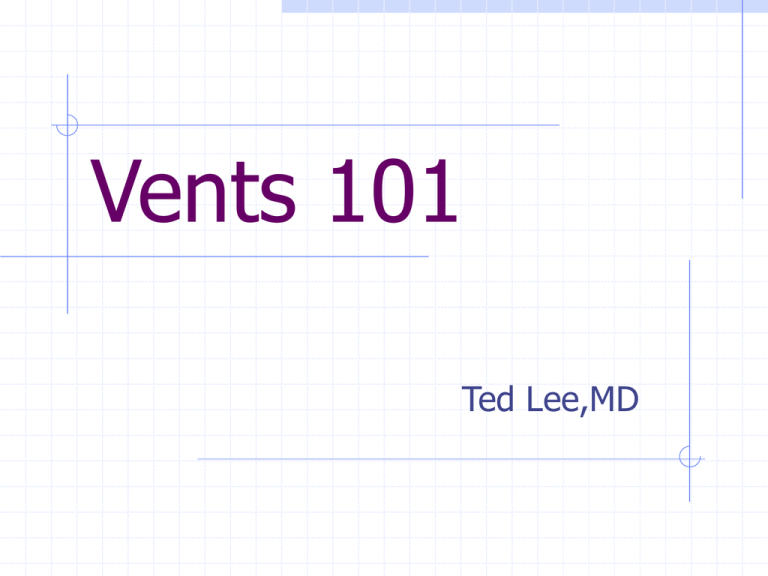
Vents 101 Ted Lee,MD Objectives Understand the basics of vent mechanics Describe the various modes of ventilation Learn how to initiate mech. ventilation Learn how to troubleshoot problems Vent demonstration workshop with Hank Lockridge, RCP, RRT Basic Vent Mechanics Ideal gas law PV=nRT Volume is inversely related to pressure You can’t control both vol. and pressure Choose one as the constant and the other one varies. Basically, modes of ventilation are broken down into pressure or volume. Pressure as the Constant Pressure Control Constant pressure over a preset time Tidal Volume will vary depending on compliance and resistance Modes can be AC or SIMV Pressure Support Constant pressure at a preset flow rate Support breaths end when flow rate decreases from initial rate to a preset level. Pt controls RR, which is the most comfortable. Volume as the Constant Volume-cycled ventilation Tidal volume is preset The pressure then varies Therefore we need to set pressure alarms Basic Modes are AC or SIMV AC – extra breaths are at full tidal volume SIMV – set backup rate and extra breaths are at variable volumes based on pt effort and pressure support. Pros and Cons of each mode Mode Pros Cons AC volume -reduced WOB -VT is guaranteed unless AC pressure -reduced WOB -allows for PIP limits SIMV -maybe less hyperinflation -inc WOB compared to AC -less interference with -uncomfortable for pt, Pressure support peak pressure exceeded -potential hyperventilation -hemodynamic effects -excessive insp pressures -hyper/hypoventilation as resistance/compliance changes cardiovascular fxn? since volume varies -most comfortable mode -improve synchrony -reduced WOB -VT is variable -pt must have intact respiratory drive Initiation of Ventilation Choose a mode that will: Provide adequate oxygenation Reduce work of breathing Provide synchrony b/w pt and vent Avoid high peak/plateau pressures Start Fi02 at 100%, then titrate down Initial Tidal Volume of 10cc/kg Keep Plateau pressure less than 30 Initiation of Ventilation (cont.) Consider PEEP, start at 5 then titrate up Provide enough PS if using SIMV Watch out for Auto-PEEP! Provide adequate sedation and analgesia If you make any changes, observe closely to see how the changes affect your patient. Trouble Shooting If BP or HR suddenly drops or pt codes: Disconnect pt from vent and start bagging Look for mucous plug, tension ptx, etc. Bag slowly to allow enough expiratory time If high pressure alarm goes off: Look for pt/vent asynchrony Is there a better mode? Is pt adequately sedated? What’s the problem with the ABG? Oxygenation (PaO2) or Ventilation (PaCO2)? Vent dynamics affecting PaO2 Fi02 Mean Airway Pressure PEEP Vent dynamics affecting PaCO2 Respiratory Rate Tidal Volume Dead Space Compliance vs. Resistance Peak pressure is Dynamic Compliance which includes airway resistance Plateau pressure is Static Compliance Roughly speaking, resistance is the difference between Peak and Plateau pressures. Peak and Plateau Pressures www.ccmtutorials.com Compliance Problem Plateau pressure is elevated > 30 Peak pressure is only slightly higher than plateau pressure Decrease the tidal volume as tolerated Treat the underlying problem Pneumonia? Pulmonary edema? Tension Pneumothorax? Resistance Problem Peak pressure is elevated Plateau pressure is usually normal Allow for enough expiratory time Watch for Auto-PEEP Treat the underlying problem Bronchoconstriction? Mucous plugging? Kinked endotracheal tube? Auto-PEEP What is it? Air gets in, but not all of it comes out. “Breath Stacking” which increases intrathoracic pressure & dec. venous return Decrease tidal volume as tolerated Increase expiratory time by: Decreasing respiratory rate Increasing inspiratory flow rate www.ccmtutorials.com www.ccmtutorials.com Example of Auto-PEEP www.ccmtutorials.com References and Resources Fundamentals of Critical Care Support, Society of Critical Care Medicine www.ccmtutorials.com


